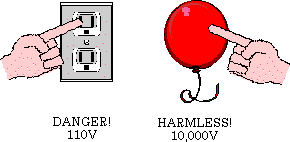

Try these "busters" to exercise your brain ... they should help you grasp the concepts underlying electric potential, etc. To gain the maximum effect you should attempt to answer them before looking at the answers!
[1] A positive point charge and a negative point charge have equal magnitudes. Which (different) corners of the square should they be placed in order that the same potential exists on the "open" corners? Explain your reasoning.
[2] Three point charges, two are positive and one is negative but they have the same magnitude, are fixed one to each corner of a square. How do you arrange them so that the potential at the vacant corner is positive?
[3] What point charges, all of the same magnitude, would you place, one to each corner of a square, so that the electric field and the electric potential are zero at the center? Explain your reasoning.
[4] The electric field at a point in space is zero. Does this mean that the electrical potential at the same place is zero?
[5] A proton is fixed in space. An electron is released from rest and allowed to collide with the proton. Now reverse the roles, i.e., the electron is fixed and the proton is released. Which is traveling faster when the collision occurs, the proton or the electron? Explain your answer.
[6] A positive test charge is placed in an electric field. In what direction should the charge be moved, relative to the field, so that it experiences a constant electric potential?
[7] Imagine you are moving a positive test charge along the line between two, fixed, identical point charges. Thinking of the electric potential, is the midpoint analogous to the top of a hill or the bottom of a valley? Does it make a difference if the charges are both positive or both negative? What if the test charge is negative?
[8] A proton and an electron, initially at rest, are released from the midpoint between two, parallel plates, one charged positive and the other charged negative. Ignoring any attraction between the two particles, which strikes a plate first? Why?

[9] A positive charge is released from rest in an electric field. Does it move towards a region of higher or lower electric potential?
[10] Imagine of a ring of charge. Does the electric potential at a point, P, on the axis of the ring depend on whether the charge is distributed uniformly around the ring or not? What about the electric field E?

[11] Imagine two metal spheres A and B each with the same charge Q; A has radius RA and B has radius RB with RA > RB. Describe what happens if the two spheres are connected to each other by a conducting wire. What if A and B were point charges?
[12]

When you rub a balloon with a piece of woollen cloth it can attain a potential of 10,000V. So, how come you can touch a balloon at a potential of 10,000V and yet you are likely to receive a severe 'jolt' if you stick your finger in a 110V socket?
[13] A proton (charge +e) is fired towards a helium nucleus (charge +2e). If the proton follows the path shown below,

what can you say (if anything) about its speed at the points 1 and 2? For example, are the speeds the same, is the speed at 1 greater than the speed at 2, is the speed at 1 less than the speed at 2, or do you need further information? If, the latter, what information?
[14] What do the equipotential surfaces look like in the neighborhood of a positive charge placed close to a conducting slab, as shown below?

[15] Can you think of any situation where equipotential surfaces intersect?
[16] If a conductor is brought near to an isolated positive charge , charges in the conductor will re-distribute so that the end of the rod nearer to the positive charge will be negative, the end further away will be positive, as shown below.

Can you sketch the variation of the electric potential with position in the vicinity of the rod and the charge?